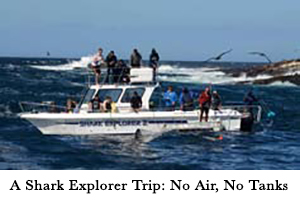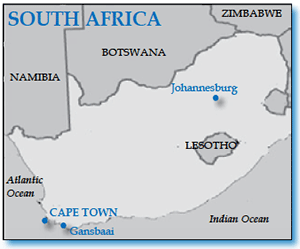Shark Explorers, Cape Town, South AfricaContents of this Issue: Shark Explorers, Cape Town, South Africa Mozambique, Mexico, Philippines . . . Divers, Your Very Presence Affects Reef Fish Behavior Just Think, He Might Have Been in Your Dive Class Barracuda Slaughter at McCauley Memorial Letters about our Latest Articles Is Your Camera Hurting Marine Life? Editorial Office: Ben Davison Publisher and Editor Undercurrent 3020 Bridgeway, Suite 102 Sausalito, CA 94965 only if you must see great whites in any way possible from the October, 2015 issue of Undercurrent
Great white shark diving is a big business in Cape Town, so many American divers headed to South Africa for a land safari often set aside a couple days to dive with the big guys. Trouble is, like any sort of diving, trips get canceled, and if yours does during high season, you may find yourself shut out of shark diving. One of our veteran reporters took his chances and, well, his trip was canceled and he struggled to find another option, a pretty bare-bones one at that. Should the sharks of Cape Town be on your bucket list, go forewarned. * * * * * Dear Fellow Diver: Admit it. You've seen Jaws umpteen times. You watch Shark Week every year, have seen Big Fluffy banging on the cage off Guadelupe Island, were amazed by the size of the female great whites at Stewart Island and gawped over Air Jaws erupting from the sea in South Africa. And you know you want to see the teeth. You want to see "lifeless eyes, black eyes, like a doll's eyes." You want to be in the cage. I admit it, too. So it was on a recent trip to South Africa that I found myself off Seal Island, shoulder-deep in 55-degree water, clinging to the top of a re-bar cage, waiting.
They did, and it was. Except now the pick-up time would be 3:45 a.m. For various reasons, like jet lag for openers, that wouldn't work, so I whipped out my trusty iPad, and came up with White Shark Projects. The woman who answered the phone was helpful, but no, they were booked, and referred us to Shark Explorers. Linda from Shark Explorers had two spots open the next day, the dock was only 45 minutes away, and they would pick us up at 8:15 a.m. It was a deal.
The boat was a 36-foot G-Cat with twin Suzuki 200 outboards, Loran, radio, cell phone and a head, or "changing room." When I asked about oxygen, I was told that because we weren't diving, there was no need. About that time, I noticed there were no tanks or a compressor for surface-supplied air. Jessica, the mate, started the briefing, and I quickly learned this was as basic as it gets. The cage would be lowered off the side of the boat about five feet deep; when a shark showed up, we were to hold our breath, duck under the surface and watch the show. (Other boats in the area were doing the same thing -- no surfacesupplied air, no tanks.) The visibility was "great," she said, or about 20 feet, and we could expect a lot of sharks. The "25-minute" trip to Seal Island actually took 45 minutes and was simultaneously spine-jolting and stomach-churning. My relief at arriving turned to dismay when we moored in the lee of the island and were treated to the reek of 60,000 Cape fur seals doing what seals do on the island and in the water. While the crew got the cage into the water, the nine passengers -- us, another American couple on their honeymoon (he talked her into this), and five Swiss, donned 7mm full body wetsuits with hoods and booties. The crew issued everyone a mask, but no snorkels. They threaded a couple of lines with well-used fish heads and heaved them overboard, along with a rubber lure resembling a swimming seal. I decided to watch and see if any sharks were working that afternoon before jumping into the chilly water. The five Swiss folks donned weight belts, jumped into the cage and stood shoulder to shoulder as the top was closed. The crew continued to pull in the chum lines and "seal" and toss them out again, slapping the choppy sea.
In five minutes, a dark shape appeared off the bow and nosed the chum line. Captain Stephen Swanson pointed and yelled, "Down, down!" The occupants of the cage took their breaths and pushed themselves underwater by pressing against the top of the cage. The shark circled toward the stern and disappeared. The guests' heads popped up to the surface. Moments later, two sharks arrived and circled in opposing directions. They left and another came in from the stern, tried to grab a fish head as the crew pulled it toward the cage, and slapped its tail in frustration. This went on for 30 minutes before the crew got the group out of the cage and it was our turn. I was the last in the cage. The cold bit like a liquid coronary. I had wanted a corner position so I could watch from two angles but Jessica, a crew member who has a passion for big biters, jumped in on my right. She does this every day and never tires of it. We all grabbed the roof of the cage, holding our heads above water. But now the sharks were used to the routine and at least five minutes passed before we heard "Down, down!" I gulped air, pushed down and an enormous female swept in from the stern, bearing a tag on her dorsal fin. She went for the fish head. We saw the jaw line elongate, teeth flash in the green water and snap shut as the crew yanked the bait away. She turned under the boat; we could see her full length as the sinuous tail sent her back into the murk. "She's tagged," Jessica shouted. "We know her. Four and a half meters!" A big fish. We waited. The action the first group was gone. We had about five more passes. With the cage attached to the boat, there was no respite from the surface chop; we bobbed up and down, forced ourselves underwater, then came up gasping. Eventually a six-footer showed up, but the big guys, not content with fish heads that got yanked away from them, were out hunting seals. I needed to escape the mal de mer before I did my own chumming, pushed the lid up and heaved myself out. The crew handed me a towel and I got the hell out of the cold suit and into the sweats I brought along. The ride back was better, with a following sea. I sat next to the honeymooning bride on the bench, and asked, "So, how's the divorce going?" Her reply: "We've been married such a short time, I think I can get an annulment." --D.L.
|

I want to get all the stories! Tell me how I can become an Undercurrent Online Member and get online access to all the articles of Undercurrent as well as thousands of first hand reports on dive operations world-wide
| Home | Online Members Area | My Account |
Login
|
Join
|
| Travel Index |
Dive Resort & Liveaboard Reviews
|
Featured Reports
|
Recent
Issues
|
Back Issues
|
|
Dive Gear
Index
|
Health/Safety Index
|
Environment & Misc.
Index
|
Seasonal Planner
|
Blogs
|
Free Articles
|
Book Picks
|
News
|
|
Special Offers
|
RSS
|
FAQ
|
About Us
|
Contact Us
|
Links
|
3020 Bridgeway, Ste 102, Sausalito, Ca 94965
All rights reserved.

 I had originally booked a one-day trip with Go Shark Diving. They were to
pick up my buddy and me at 8:30 a.m. from our Cape Town hotel, drive two hours
to Gansbaai, provide wetsuits, put us in the cage, call the sharks over, chompclick,
chomp-click, and we'd be out of the water and back to the hotel by 4:30
p.m. No sweat. So I was damn well put off when they called me the day we arrived
and canceled the next day's trip, due to "conditions," or high seas. With only
two full days in Cape Town before heading off to a safari camp, that left only
one possible shot for my Bucket List trip. Go Shark Diving said they'd call back
the next day and let us know if a trip in two days was possible.
I had originally booked a one-day trip with Go Shark Diving. They were to
pick up my buddy and me at 8:30 a.m. from our Cape Town hotel, drive two hours
to Gansbaai, provide wetsuits, put us in the cage, call the sharks over, chompclick,
chomp-click, and we'd be out of the water and back to the hotel by 4:30
p.m. No sweat. So I was damn well put off when they called me the day we arrived
and canceled the next day's trip, due to "conditions," or high seas. With only
two full days in Cape Town before heading off to a safari camp, that left only
one possible shot for my Bucket List trip. Go Shark Diving said they'd call back
the next day and let us know if a trip in two days was possible. July in South Africa is the dead of
winter. It's also great white shark season,
with sightings virtually guaranteed. When I
stepped out of our hotel the next morning,
I could see my breath. Donny, our driver,
was a lively conversationalist, pointing
out hiking trails and beaches, and soon
we were in the achingly quaint village of
Simon's Town, standing at the public dock,
watching the crew load the boat with wetsuits,
lunch and . . . cold drinks? The
air temp was now in the mid-60s but the
water wasn't, and my request for hot tea
on board was politely rebuffed.
July in South Africa is the dead of
winter. It's also great white shark season,
with sightings virtually guaranteed. When I
stepped out of our hotel the next morning,
I could see my breath. Donny, our driver,
was a lively conversationalist, pointing
out hiking trails and beaches, and soon
we were in the achingly quaint village of
Simon's Town, standing at the public dock,
watching the crew load the boat with wetsuits,
lunch and . . . cold drinks? The
air temp was now in the mid-60s but the
water wasn't, and my request for hot tea
on board was politely rebuffed. Divers Compass: Our July afternoon trip was about $140 each (
Divers Compass: Our July afternoon trip was about $140 each (